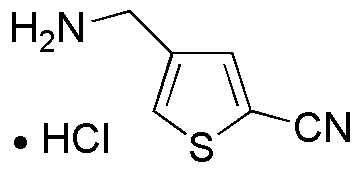4-Aminomethyl-thiophene-2-carbonitrile hydrochloride is widely utilized in research focused on:
- Pharmaceutical Development: This compound serves as an important intermediate in the synthesis of various pharmaceuticals, particularly in the development of drugs targeting neurological disorders.
- Organic Synthesis: It is used in the creation of complex organic molecules, making it valuable for researchers in organic chemistry and materials science.
- Biological Research: The compound is employed in studies investigating its biological activity, including potential antimicrobial and anticancer properties, aiding researchers in drug discovery.
- Electronics: Its unique properties make it suitable for applications in organic electronics, such as organic light-emitting diodes (OLEDs), providing a pathway for innovative display technologies.
- Polymer Chemistry: This chemical can be used to modify polymers, enhancing their properties for specific applications in coatings and adhesives, thus improving performance in various industrial applications.
General Information
Properties
Safety and Regulations
Applications
4-Aminomethyl-thiophene-2-carbonitrile hydrochloride is widely utilized in research focused on:
- Pharmaceutical Development: This compound serves as an important intermediate in the synthesis of various pharmaceuticals, particularly in the development of drugs targeting neurological disorders.
- Organic Synthesis: It is used in the creation of complex organic molecules, making it valuable for researchers in organic chemistry and materials science.
- Biological Research: The compound is employed in studies investigating its biological activity, including potential antimicrobial and anticancer properties, aiding researchers in drug discovery.
- Electronics: Its unique properties make it suitable for applications in organic electronics, such as organic light-emitting diodes (OLEDs), providing a pathway for innovative display technologies.
- Polymer Chemistry: This chemical can be used to modify polymers, enhancing their properties for specific applications in coatings and adhesives, thus improving performance in various industrial applications.
Documents
Safety Data Sheets (SDS)
The SDS provides comprehensive safety information on handling, storage, and disposal of the product.
Product Specification (PS)
The PS provides a comprehensive breakdown of the product’s properties, including chemical composition, physical state, purity, and storage requirements. It also details acceptable quality ranges and the product's intended applications.
Certificates of Analysis (COA)
Search for Certificates of Analysis (COA) by entering the products Lot Number. Lot and Batch Numbers can be found on a product’s label following the words ‘Lot’ or ‘Batch’.
Numéro de catalogue
Numéro de lot/série
Certificates Of Origin (COO)
This COO confirms the country where the product was manufactured, and also details the materials and components used in it and whether it is derived from natural, synthetic, or other specific sources. This certificate may be required for customs, trade, and regulatory compliance.
Numéro de catalogue
Numéro de lot/série
Safety Data Sheets (SDS)
The SDS provides comprehensive safety information on handling, storage, and disposal of the product.
DownloadProduct Specification (PS)
The PS provides a comprehensive breakdown of the product’s properties, including chemical composition, physical state, purity, and storage requirements. It also details acceptable quality ranges and the product's intended applications.
DownloadCertificates of Analysis (COA)
Search for Certificates of Analysis (COA) by entering the products Lot Number. Lot and Batch Numbers can be found on a product’s label following the words ‘Lot’ or ‘Batch’.
Numéro de catalogue
Numéro de lot/série
Certificates Of Origin (COO)
This COO confirms the country where the product was manufactured, and also details the materials and components used in it and whether it is derived from natural, synthetic, or other specific sources. This certificate may be required for customs, trade, and regulatory compliance.


